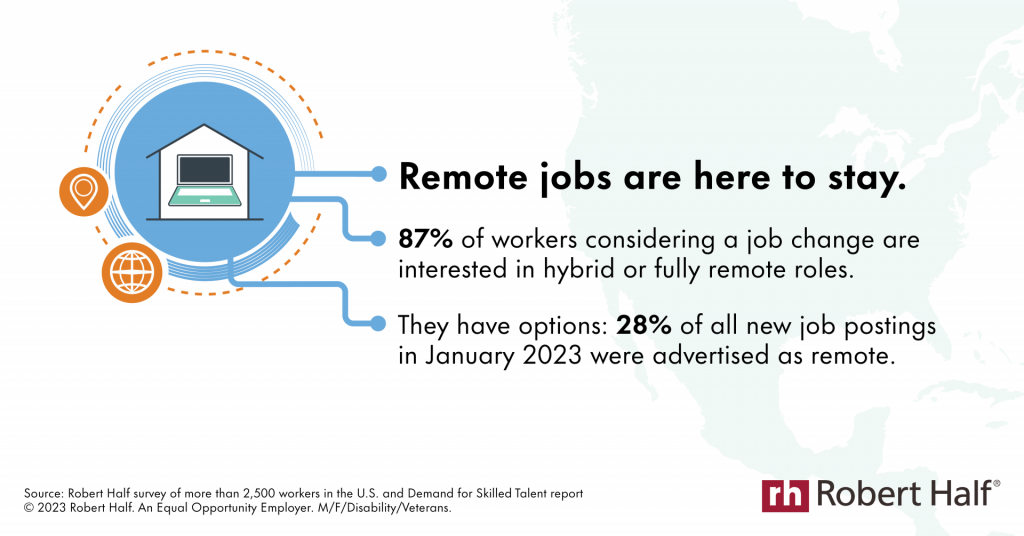Payroll
5 Trends in Remote Work for 2023
Nearly 9 in 10 workers considering a job change (87%) are interested in hybrid or fully remote positions. 28% of all new job postings in January 2023 were advertised as remote.
Mar. 02, 2023

The sudden shift to remote and hybrid work spurred significant change for employers, employees and job seekers. But after several years of adjusting, where do they stand when it comes to working in the office versus anywhere? New research from talent solutions and business consulting firm Robert Half reveals five remote work trends taking shape for 2023. View infographics of the research highlights.

Remote jobs are here to stay. Professionals remain confident in the job market, and having greater flexibility to choose where and when to work is a top motivator for making a move. Nearly 9 in 10 workers considering a job change (87%) are interested in hybrid or fully remote positions. And they have options: 28% of all new job postings in January 2023 were advertised as remote, on par with 29% a year ago. View Robert Half’s Demand for Skilled Talent report for insight on roles with the greatest percentage of remote opportunities.

Thanks for reading CPA Practice Advisor!
Subscribe for free to get personalized daily content, newsletters, continuing education, podcasts, whitepapers and more...
Already registered? Login
Need more information? Read the FAQ's
Work flexibility can lead to greater happiness. More than three-quarters of professionals (77%) who can work where and when they are most productive are putting in more hours now than three years ago. Despite longer workdays, 46% report higher job satisfaction.
Some would sacrifice salary for more remote time. Nearly one-third of workers (32%) who go into the office at least one day a week are willing to take a pay cut for the ability to do their job remotely all the time. When asked by how much, the average response was 18%. Technology professionals (47%), 18- to 25-year-olds (42%) and working parents (41%) are most likely to accept a salary reduction to be fully remote.
Being in the office has benefits. Nearly two-thirds of professionals (65%) said they have more effective relationships with colleagues they’ve met face-to-face versus those they have not. And more workers are comfortable collaborating in person (49%) than virtually (31%). Read about the benefits of working “in person with a purpose” in Robert Half’s Your Future Is Flexible report.
Employees have career opportunities, wherever they are. Most managers (82%) who oversee hybrid teams feel in-office and remote employees have the same opportunities for career advancement. Yet, 42% of remote workers are concerned about being visible for project opportunities and promotions. Managers said the best ways for off-site employees to position themselves for growth are:
Having regular career pathing conversations
Expressing interest in professional development opportunities
Volunteering to lead or contribute to projects
“Even though we’ve seen more people return to the office as of late, companies shouldn’t pull back on remote work policies,” said Paul McDonald, senior executive director of Robert Half. “Flexibility and choice are clearly non-negotiables for many professionals, and employers will lose good staff if they limit remote options without a valid reason.”
Lynne Smith, Robert Half senior vice president of global human resources, added, “Supporting a hybrid workforce is not easy. It requires extensive planning, paying attention to employee and business needs, and pivoting to get right. But there are huge benefits of embracing a people-first, flexible work philosophy, including a more engaged and productive team.”
